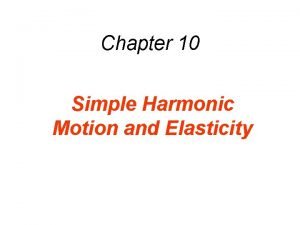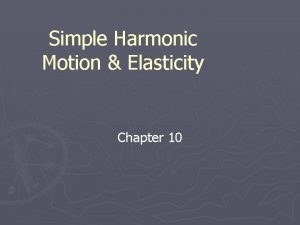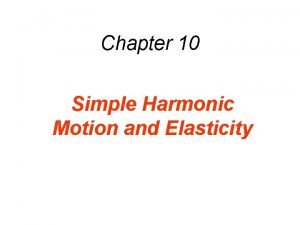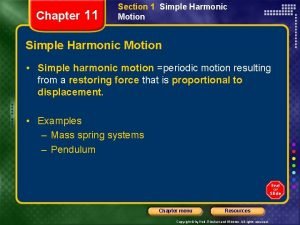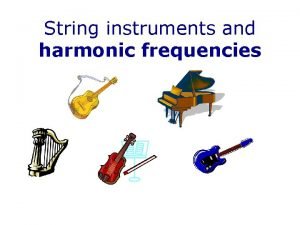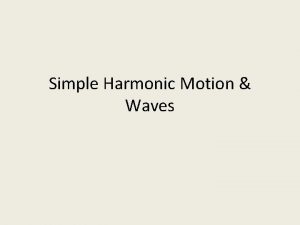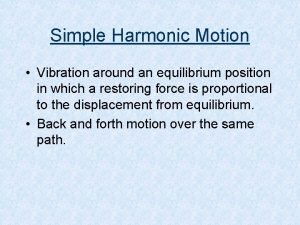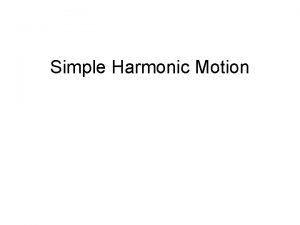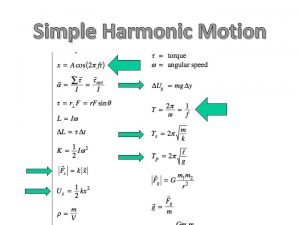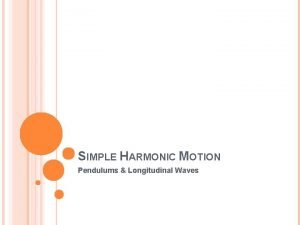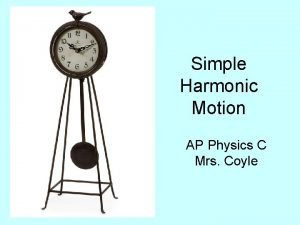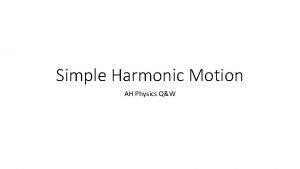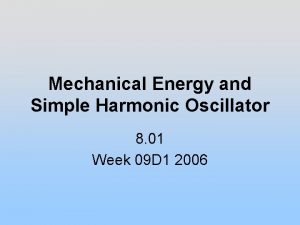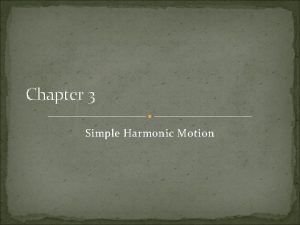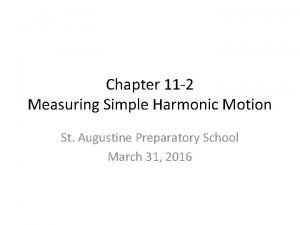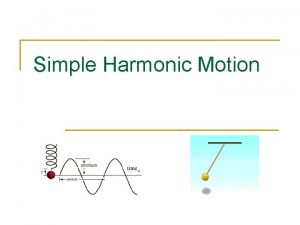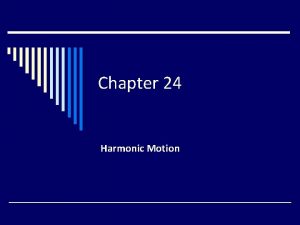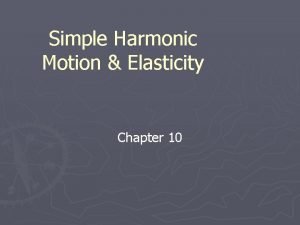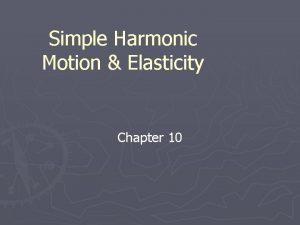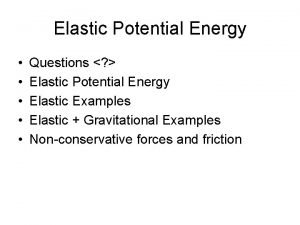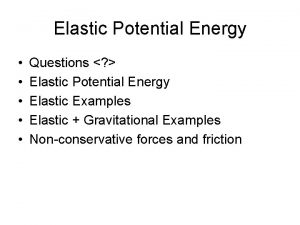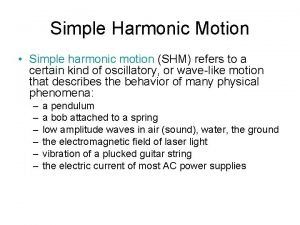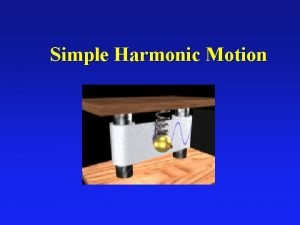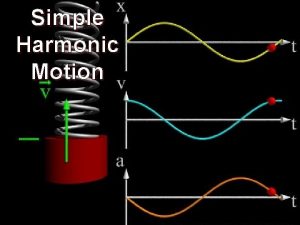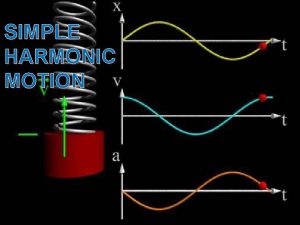Simple Harmonic Motion Elasticity Chapter 10 Elastic Potential
















- Slides: 16

Simple Harmonic Motion & Elasticity Chapter 10

Elastic Potential Energy ► What is it? § Energy that is stored in elastic materials as a result of their stretching. ► Where is it found? § § § § Rubber bands Bungee cords Trampolines Springs Bow and Arrow Guitar string Tennis Racquet

Hooke’s Law A spring can be stretched or compressed with a force. ► The force by which a spring is compressed or stretched is proportional to the magnitude of the displacement (F x). ► Hooke’s Law: ► Felastic = -kx Where: (N/m) k = spring constant = stiffness of spring x = displacement

Hooke’s Law ► What is the graphical relationship between the elastic spring force and displacement? Felastic = -kx Slope = k Displacement

Hooke’s Law ► A force acting on a spring, whether stretching or compressing, is always positive. § Since the spring would prefer to be in a “relaxed” position, a negative “restoring” force will exist whenever it is deformed. § The restoring force will always attempt to bring the spring and any object attached to it back to the equilibrium position. § Hence, the restoring force is always negative.

Example 1: ► A 0. 55 kg mass is attached to a vertical spring. If the spring is stretched 2. 0 cm from its original position, what is the spring constant? ► Known: m = 0. 55 kg x = -2. 0 cm g = 9. 81 m/s 2 ► Felastic Equations: Fnet = 0 = Felastic + Fg (1) Felastic = -kx (2) Fg = -mg (3) Substituting 2 and 3 into 1 yields: k = -mg/x k = -(0. 55 kg)(9. 81 m/s 2)/-(0. 020 m) k = 270 N/m Fg

Elastic Potential Energy in a Spring ► The force exerted to put a spring in tension or compression can be used to do work. Hence the spring will have Elastic Potential Energy. ► Analogous to kinetic energy: PEelastic = ½ kx 2

Example 2: ►What is the difference in the potential ►A 0. 55 kg mass is attached to aelastic vertical spring with energy the system when the If deflection is is a springofconstant of 270 N/m. the spring maximum 4. 0 in either theits positive orposition, negativewhat is stretched cm from original direction? the Elastic Potential Energy? ► Known: m = 0. 55 kg x = -4. 0 cm k = 270 N/m g = 9. 81 m/s 2 ► Felastic Equations: PEelastic = ½ kx 2 PEelastic = ½ (270 N/m)(0. 04 m)2 PEelastic = 0. 22 J Fg

Elastic Potential Energy ► What is area under the curve? Displacement A = ½ b h A = ½ x F A = ½ x k x A = ½ k x 2 Which you should see equals the elastic potential energy

What is Simple Harmonic Motion? ►Simple harmonic motion exists whenever there is a restoring force acting on an object. § The restoring force acts to bring the object back to an equilibrium position where the potential energy of the system is at a minimum.

Simple Harmonic Motion & Springs ► Simple Harmonic Motion: § An oscillation around an equilibrium position will occur when an object is displaced from its equilibrium position and released. § For a spring, the restoring force F = -kx. ► The spring is at equilibrium when it is at its relaxed length. (no restoring force) ► Otherwise, when in tension or compression, a restoring force will exist.

Simple Harmonic Motion & Springs ► At maximum displacement (+ x): § The Elastic Potential Energy will be at a maximum § The force will be at a maximum. § The acceleration will be at a maximum. ► At equilibrium (x = 0): § The Elastic Potential Energy will be zero § Velocity will be at a maximum. § Kinetic Energy will be at a maximum § The acceleration will be zero, as will the unbalanced restoring force.

► ► Harmonic Motion & Simple The Pendulum Simple Pendulum: Consists of a massive object called a bob suspended by a string. Like a spring, pendulums go through simple harmonic motion as follows. Where: T = period l = length of pendulum string g = acceleration of gravity ► Note: 1. 2. This formula is true for only small angles of θ. The period of a pendulum is independent of its mass.

Conservation of ME & The Pendulum ► In a pendulum, Potential Energy is converted into Kinetic Energy and vise-versa in a continuous repeating pattern. § § ► PE = mgh KE = ½ mv 2 MET = PE + KE MET = Constant Note: 1. 2. 3. Maximum kinetic energy is achieved at the lowest point of the pendulum swing. The maximum potential energy is achieved at the top of the swing. When PE is max, KE = 0, and when KE is max, PE = 0.

Key Ideas ► Elastic Potential Energy is the energy stored in a spring or other elastic material. ► Hooke’s Law: The displacement of a spring from its unstretched position is proportional the force applied. ► The slope of a force vs. displacement graph is equal to the spring constant. ► The area under a force vs. displacement graph is equal to the work done to compress or stretch a spring.

Key Ideas ► Springs and pendulums will go through oscillatory motion when displaced from an equilibrium position. ► The period of oscillation of a simple pendulum is independent of its angle of displacement (small angles) and mass. ► Conservation of energy: Energy can be converted from one form to another, but it is always conserved.
 Simple harmonic motion and elasticity
Simple harmonic motion and elasticity Simple harmonic motion and elasticity
Simple harmonic motion and elasticity Damped oscillation
Damped oscillation Simple harmonic motion formulas
Simple harmonic motion formulas Simple harmonic motion chapter 11
Simple harmonic motion chapter 11 Wave
Wave Simple harmonic motion vocabulary
Simple harmonic motion vocabulary Simple harmonic motion equilibrium position
Simple harmonic motion equilibrium position Simple harmonic motion springs
Simple harmonic motion springs Shm reference circle
Shm reference circle Simple harmonic motion formula
Simple harmonic motion formula Harmonics equations
Harmonics equations Shm
Shm Graphical representation of shm
Graphical representation of shm Simple harmonic oscillator
Simple harmonic oscillator Simple harmonic motion
Simple harmonic motion A 125 n object vibrates
A 125 n object vibrates
